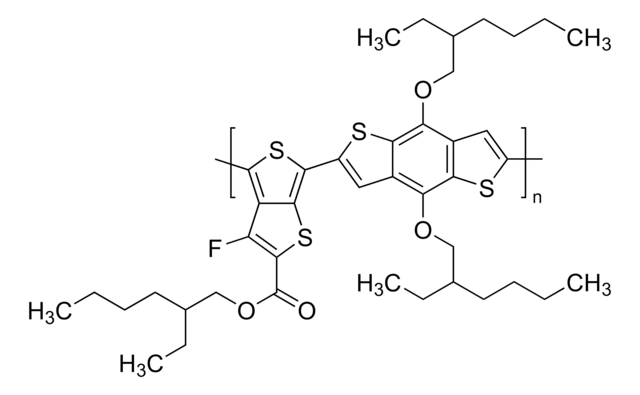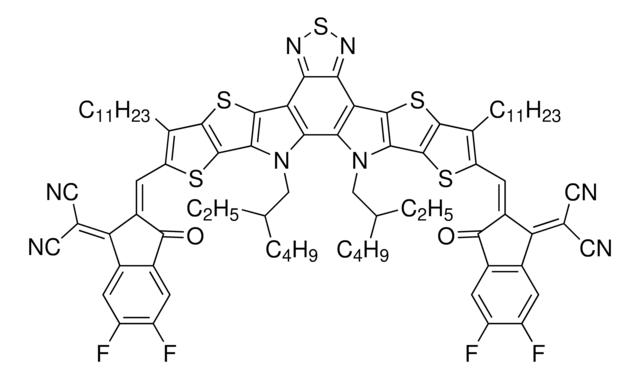753998
PCDTBT
Sinónimos:
Poly[N-9′-heptadecanyl-2,7-carbazole-alt-5,5-(4′,7′-di-2-thienyl-2′,1′,3′-benzothiadiazole)], Poly[[9-(1-octylnonyl)-9H-carbazole-2,7-diyl]-2,5-thiophenediyl-2,1,3-benzothiadiazole-4,7-diyl-2,5-thiophenediyl]
About This Item
Productos recomendados
descripción
Band gap: 1.9 eV
Formulario
solid
mol peso
average Mw 100,000-140,000
pérdida
0.5 wt. % TGA, 409 °C
mp
270-300 °C
temperatura de transición
Tm >400 °C
λmáx.
576 nm
Energía orbital
HOMO -5.5 eV
LUMO -3.6 eV
rendimiento de la unidad OPV
ITO/MoO3-Al/PCDTBT:PC71BM/MoO3/Al
- Short-circuit current density (Jsc): 10.88 mA/cm2
- Open-circuit voltage (Voc): 0.88 V
- Fill Factor (FF): 0.71
- Power Conversion Efficiency (PCE): 6.77 %
ITO/PEDOT:PSS/PCDTBT:PC71BM (1:4)/TiOxAl
- Short-circuit current density (Jsc): 11.32 mA/cm2
- Open-circuit voltage (Voc): 0.88 V
- Fill Factor (FF): 0.69
- Power Conversion Efficiency (PCE): 6.9 %
ITO/PEDOT:PSS/PCDTBT:PC71BM/Al
- Short-circuit current density (Jsc): 9.7 mA/cm2
- Open-circuit voltage (Voc): 0.82 V
- Fill Factor (FF): 0.61
- Power Conversion Efficiency (PCE): 5.3 %
propiedades de los semiconductores
P-type (mobility=6×10−5 cm2/V·s)
¿Está buscando productos similares? Visita Guía de comparación de productos
Descripción general
Aplicación
Código de clase de almacenamiento
11 - Combustible Solids
Clase de riesgo para el agua (WGK)
WGK 3
Punto de inflamabilidad (°F)
Not applicable
Punto de inflamabilidad (°C)
Not applicable
Elija entre una de las versiones más recientes:
¿Ya tiene este producto?
Encuentre la documentación para los productos que ha comprado recientemente en la Biblioteca de documentos.
Artículos
The development of high-performance conjugated organic molecules and polymers has received widespread attention in industrial and academic research.
Organic materials in optoelectronic devices like LEDs and solar cells are of significant academic and commercial interest.
Organic photovoltaics (OPVs) represent a low-cost, lightweight, and scalable alternative to conventional solar cells. While significant progress has been made in the development of conventional bulk heterojunction cells, new approaches are required to achieve the performance and stability necessary to enable commercially successful OPVs.
Thin, lightweight, and flexible electronic devices meet widespread demand for scalable, portable, and robust technology.
Filtros activos
Nuestro equipo de científicos tiene experiencia en todas las áreas de investigación: Ciencias de la vida, Ciencia de los materiales, Síntesis química, Cromatografía, Analítica y muchas otras.
Póngase en contacto con el Servicio técnico
![Poly[(9,9-di-n-octylfluorenyl-2,7-diyl)-alt-(benzo[2,1,3]thiadiazol-4,8-diyl)] average Mn ≤25000](/deepweb/assets/sigmaaldrich/product/structures/428/661/1c4ebb98-9d51-48c0-96c7-e556ca425aa4/640/1c4ebb98-9d51-48c0-96c7-e556ca425aa4.png)



![[6,6]-Phenyl C71 butyric acid methyl ester 99%](/deepweb/assets/sigmaaldrich/product/structures/716/624/9fb9f2f0-ae99-429f-8d3a-b12267976a4d/640/9fb9f2f0-ae99-429f-8d3a-b12267976a4d.png)



